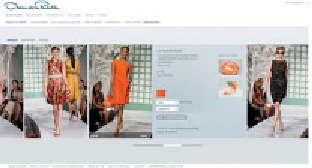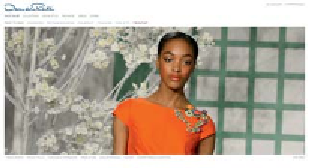Information Technology Reference
In-Depth Information
Figure 6.6
The majority of existing e-stores has incorporated interactive
features like zoom and alternative view options for product visualization. Most
of these enable selecting and zooming in on specific parts of the image and,
although these features are visually stimulating, consumers are currently asking
for a more personal type of interactivity through the web and physical channels.
Oscar de la Renta goes a step further by providing full-screen zoom of static
images for a higher online visual impact and an offline personal shopping service
to complement the online offering leading to an entirely personalized shopping
experience
It is now common to find zoom, 360º and spin applications as well as alter-
native views and matching styles, integrated in online stores. Also common-
place are tools that trace the pages viewed, tools that suggest complementary
products and those that filter preferences in order to pull up items that could
correspond to the shopper's tastes. Online shoppers also expect to find prod-
uct information including details, size charts, materials, care guide and tools
to forward, share and add commentary and wish lists or ask a style expert
some questions. These features are all a given and are no longer elements
that could captivate the online shopper. What luxury clients expect from
e-boutiques in terms of merchandizing are tools that will enable them to
interact with the products in a collaborative environment that thrives on
inclusion, fun, immersion and overall enhanced value. One such tool is the
use of a virtual model in the form of an avatar to try on products or test them
against a human form or image. This is particularly relevant as the sensory
nature of luxury goods means that there is a strong factor for the need to
interact with the products on a more personal level (Figure 6.6).
Avatars were first introduced into the fashion accessories arena by Coach in
the early noughties. This tool was integrated in the e-store to enable shoppers
to visualize the appearance of handbags against a human form. The avatars
appeared in two standard sizes (short and tall) and could display the bags in
two formats (hand-held and shoulder-hung). Although this introduced a new
level of interactivity in e-merchandizing, Coach's virtual model remained
restrictive as its two-dimensional and static nature prevented the shopper from
personalizing the product views. Since then, the technology that powers virtual
models has evolved and three-dimensional avatars have been invented. One
such application is My Virtual Model (MVP) created by the Montréal-based
company of the same name (Figure 6.7). MVP enables the creation of a 3-D
human avatar in a personalized format through integrating the body features





